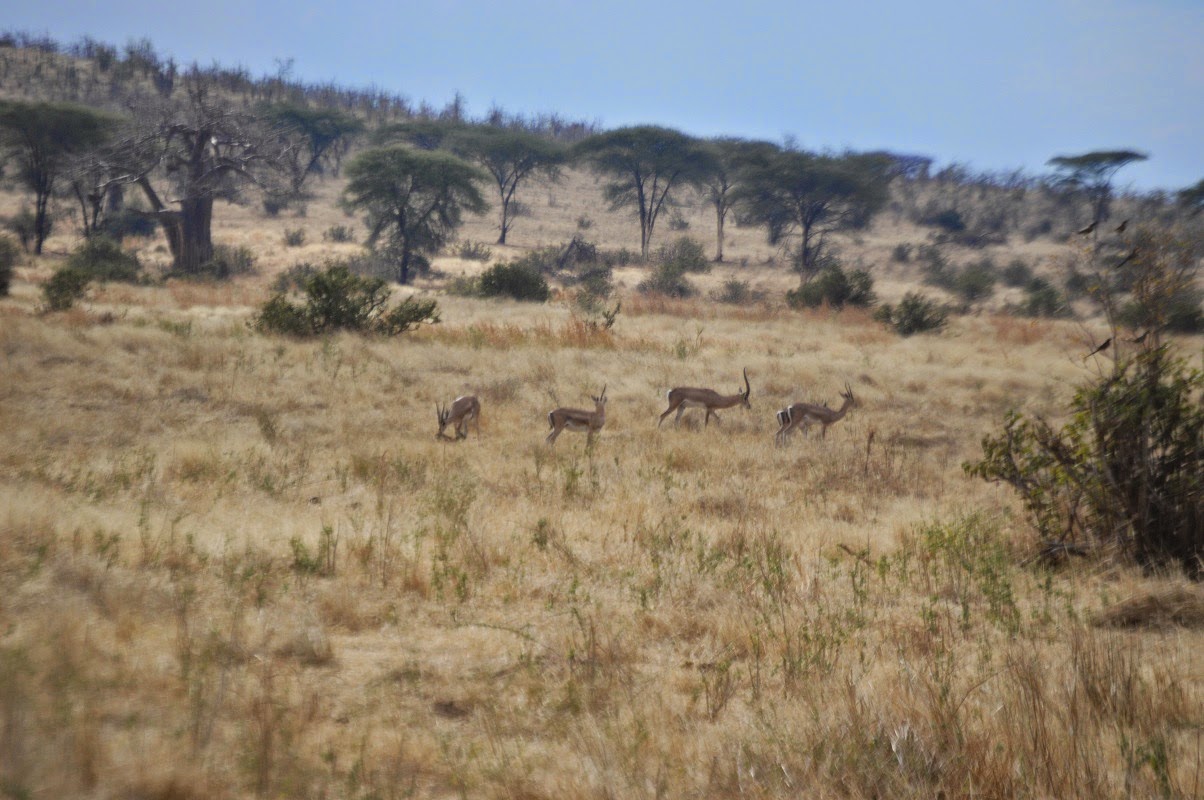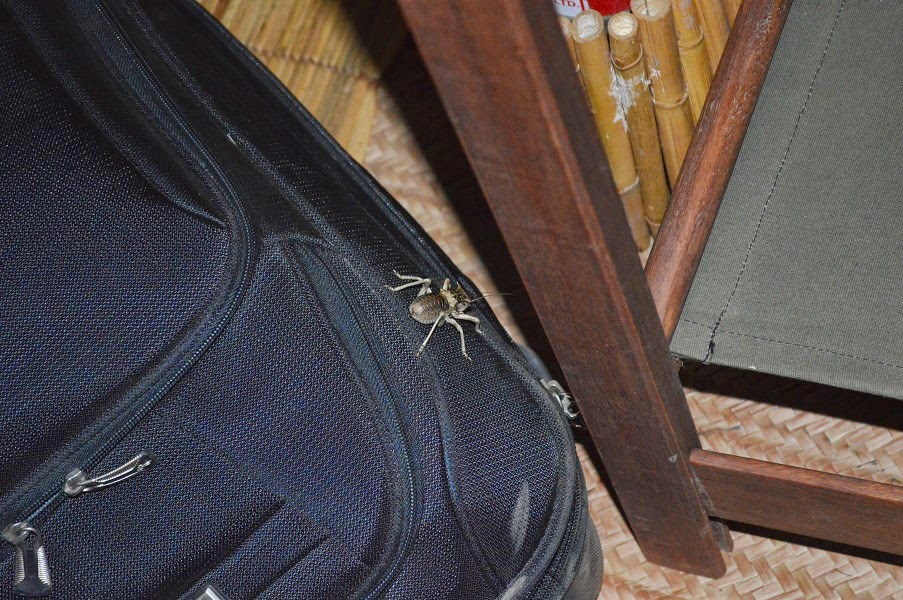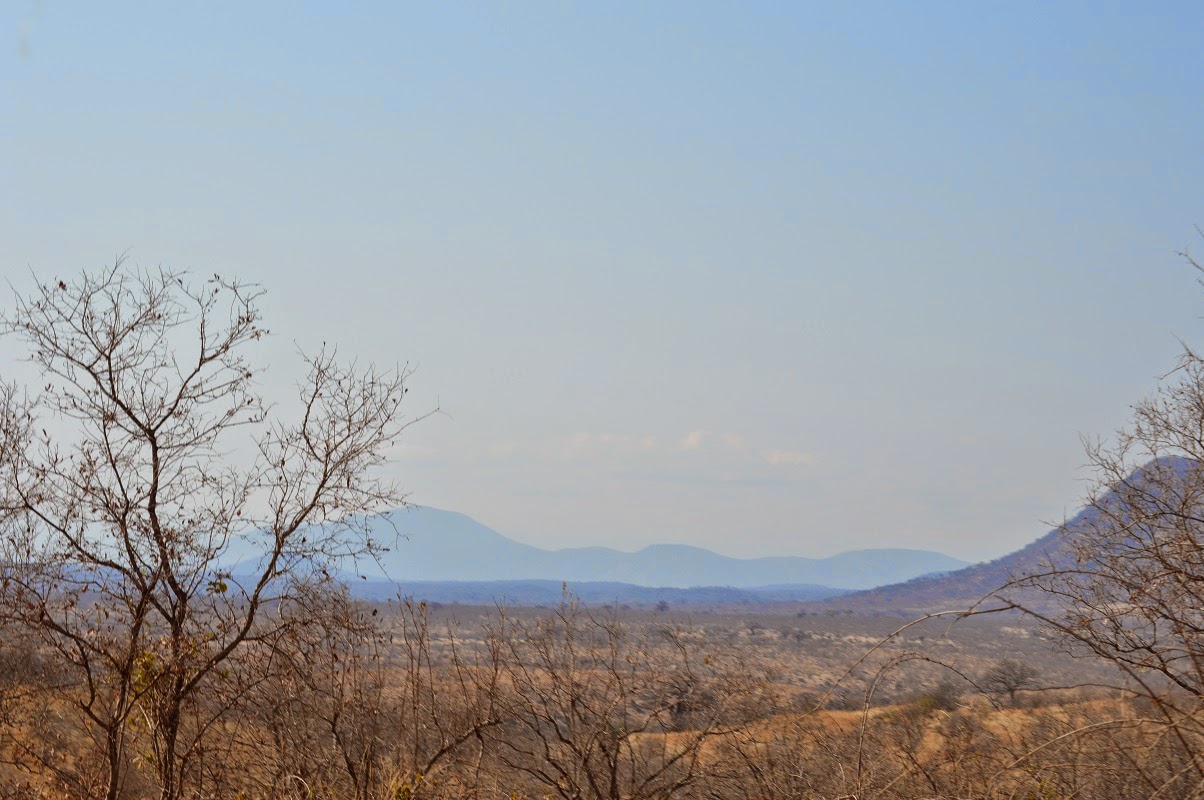
We were a bit late getting into our game drive vehicles, and we took off on a headlong drive to our first viewing opportunity; someone from another camp had spotted a special sight and had communicated its location by radio to all the other guides, and we had to hurry to be there to make sure that we did not miss chance. And it was very much worth the rush: a leopard was lying under a tree! we watched for nearly twenty minutes, pleased when it looked our way, and when it yawned, and especially when it got to its feet, walking away and showing its muscles as it did so.
While we were watching the leopard, we noticed a dove on a nearby branch which was not the usual blue/grey variety with a white tail: an emerald spotted wood dove
Finally we pulled away in search of other sights, then suddenly realized that we had a problem. Throughout our driving, we kept elephant dung burning in a coffee can tied onto the back of the land rover: when we were stopped, the fumes from the burning dung would drive away the tse tse flies
But the burning dung had fallen out of the can when the land rover has lurched backwards in the course of extrication from the bush; so the driver had to douse it, lest an uncontrolled fire get going
After passing by a nice two-trunk tree,
another elephant right by the side of the road,
and startling some zebra as we drove by,
we passed into a more open area where we paused for a pit stop as well as a group photo with Maulidi Hussein, our guide
In the field were a rufous crowned roller
a blacksmith plover
a mixed group of impala
and an area studded with baobab trees
Here a euphorbia candelabrum is growing together with another tree
I liked this tree trunk, too
We could tell that these three giraffe are all female because they have so much tuft left on their ossicones, or horns; the males wear them off the hair while fighting for dominance
A viewing of these female ostrich in the distance
was followed by something much more interesting in the foreground: almost hidden in the grass near us, a leopard could be seen stalking some impala in the mid-distance
 |
| Impala being stalked by a leopard in Ruaha National Park |
 |
| Leopard on the prowl |
 |
| Leopard stalking impala |
A pair of giraffe standing near the impala suddenly began staring in the direction of where the tiger had been moving through the grass. The impala suddenly began showing caution, looking toward the stalking leopard as well. The giraffe which may well have signaled to the impala that danger was afoot — Maulidi explained that prey animals have ways of communicating about danger with other species as well as their own
Eventually, the impala shifted their grazing further away, and we lost sight of the leopard in the grass. We drove off, but the vehicle carrying the rest of our party remained; they told us that, about twenty minutes after we left, the leopard sauntered across the road right in front to them, apparently having given up the hunt.
We drove across the savannah toward a likely spot for a lunch break, passing this nice tableau of zebra and impala grazing together
some giraffe
and this giraffe drinking, with its legs splayed out like that skeleton we had seen earlier in our trip
Here is the buffet lunch we enjoyed
Then we drove off again; the road signed indicated that we were headed toward the “Little Serengeti,” which I assume meant that it would be a large plain full of animals. We were really moving when I spotted some greater kudu at which I’d have liked to look more closely, but even though I indicated interest, the land rover did not so much as slow down. I had learned to respect Maulidi’s judgment, so I bit my tongue – I assumed we were not stopping for a good reason.
And indeed there was: we could see a couple of vehicles paused ahead,
and we pulled up to see what they were seeing: a cheetah resting in the shade beside a tree
As we gazed at the animal resting comfortably on the ground, Maulidi talked to us about some of the feature that contributed to its success as a hunter: the small, aerodynamically shaped head that let it run so fast, and black markings under the eyes, comparable to the black that football players paint under their eyes, that keeps the bright sunshine from reflecting back into their eyes as they give chase to their prey.
The cheetah excited us by looking up, and standing up, then sitting and looking out in the distance
– might we see it take off after some game?
It stretched out, showing off its musculature, and bared its teeth
Then, it lay back down, and the excitement was over.
Finally, we reached with Little Serengeti, where the plains stretched out into the distance
We were at another location on the Ruaha River
with more giraffe close by
and a herd of cape buffalo
and other game
as well as very large sausage fruit tree
It was past the middle of the afternoon, and we were a long way from Old Mdonya River Camp; it was time to start driving back. Along the way, we spotted a brown snake eagle on a tree; it flew across the sky to another tree
A male ostrich trotted along the road beside us
After passing another herd of elephant keeping their “little” ones close,
we saw a herd of Grant’s Gazelle
and this nice lone baobab with bark stripped well down
Along the road were a buff-crested bustard
a banded mongoose;
we had passed scores of bare-faced goaway birds (what a name!) and I finally got this nice shot of one
We passed both a solitary greater kudu
and a small herd of lesser kudu
As we closed in on our camp, we saw a troop of black-faced vervet monkeys (other guests had reported seeing them in the Old Mdonya River Camp itself)
The sky was already starting to turn pink as we got back to camp
We hurried to take our showers while the solar-heated water was still warm -- Nancy had to let it run for ten minutes but got to enjoy a hot shower; I was a little less lucky. We were out to the the campfire well before 7 PM, after I made an unsuccessful attempt to check in for our Ethiopian Airlines flight two days hence; but every time I selected an "available seat" the seat was showing as unavailable.
The group decided that, rather than take a meandering trip back to the airport the next morning, which would have required us to skip the regular breakfast which began at 7 AM, they would rather have a more leisurely breakfast at 7 and then drive straight to the airport.
Nancy got quite a start noticing what we assumed was a nasty-looking large spider on her suitcase; I asked assistant camp director Ricardo what it was; he asked me to zoom in on the photo and pointed out that it could not be a spider because it had only six legs; it was a horned cricket.
While I was on the way to breakfast, this white-headed buffalo weaver was kind enough to pause for a portrait right next to the burnt-out campfire
Even though we left camp needed to go straight to the airport, we still had time to pause for a few nice views; indeed, we spotted an animal we had not yet seen at all during our four days of safari, these bush buck, which are nocturnal and hence generally not seen in the daytime
We finally saw the tawny eagle in the right light for a good photograph
We looked at the mountains in the distance that we would have to approach to reach the airport in time
Our scheduled flight from Ruaha to Dar was on Auric, was the fourth airline in as many single-propeller plane trips. For the first time, though, our pilot was a black African (I confess I had begun to wonder if this were a profession that remained segregated in Tanzania). Although we had seen lions at some distance, feasting on an elephant carcass, on our drive toward camp from the airport on our first day in Ruaha, we had not seen any up close; so it was with some surprise that we looked out the window of the plane to see a small pride resting along the runway. We had this nice view of the Ruaha River from the our plane windows
The plane made a stop at the Iringa airport;
it was still a small airport, but not so small to have an air-conditioned waiting area with wi-fi, and not so small that the plane could not get refueled. The refueling system was a bit more basic than what we were used to; a fuel drum was rolled out to the plane, then a line was run from the drum into the plane’s left wing
The plane’s weight had to be balanced, so a second drum was rolled out and the process was repeated on the right wing. Then, we were on our way to Dar es Salaam.




































































